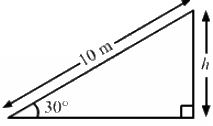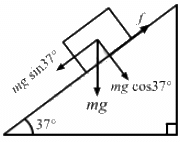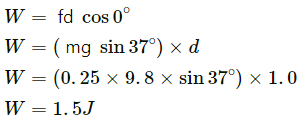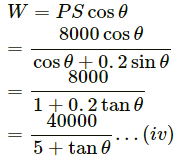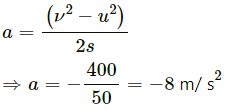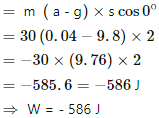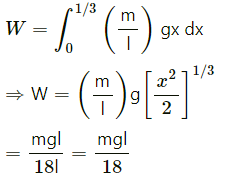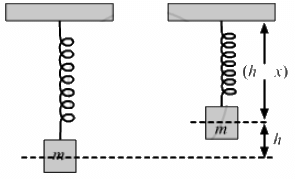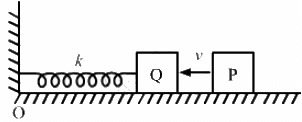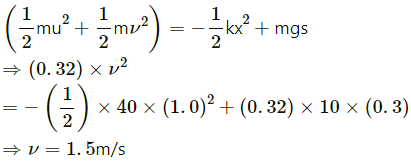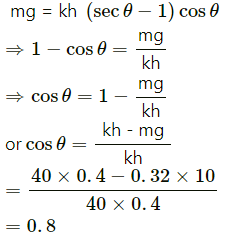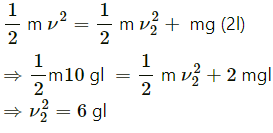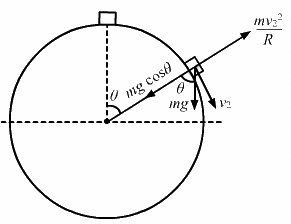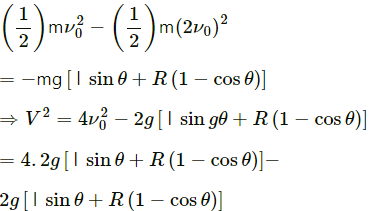HC Verma Questions and Solutions: Chapter 8- Work & Energy- 2 | HC Verma Solutions - JEE PDF Download
Exercise
Q.1. The mass of a cyclist together with the bike is 90 kg. Calculate the increase in kinetic energy if the speed increases from 6⋅0 km/h to 12 km/h.
Total mass of the system (cyclist and bike), M = mc + mb = 90 kg
Initial velocity of the system, u = 6.0 km/h = 1.666 m/sec
Final velocity of the system, v = 12 km/h = 3.333 m/sec
From work-energy theorem, we have:
Q.2. A block of mass 2.00 kg moving at a speed of 10.0 m/s accelerates at 3.00 m/s2 for 5.00 s. Compute its final kinetic energy.
Mass of the block, Mb = 2kg
Initial speed of the block, u = 10m/s
Also, a = 3m/s2 and t = 5s
Using the equation of the motion, we have:
Q.3. A box is pushed through 4.0 m across a floor offering 100 N resistance. How much work is done by the resisting force?
Resisting force acting on the box, F = 100N
Displacement of the box, S = 4 m
Also,
θ = 180º
∴ Work done by the resisting force,
Q.4. A block of mass 5.0 kg slides down an incline of inclination 30° and length 10 m. Find the work done by the force of gravity.
Mass of the block, M = 5 kg
Angle of inclination, θ = 30º
Gravitational force acting on the block,
F = mg
Work done by the force of gravity depends only on the height of the object, not on the path length covered by the object.
Height of the object , h = 10 x sin30º
= 10 x (1/2) = 5m
∴ Work done by the force of gravity, w = mgh
= 5 x 9.8 x 5 = 245J
Q.5. A constant force of 2⋅5 N accelerates a stationary particle of mass 15 g through a displacement of 2⋅5 m. Find the work done and the average power delivered.
Given:
F = 2 . 50 N, S = 2 . 5 m and m = 15 g = 0 . 015 kgWork done by the force,
(acting along the same line)
Acceleration of the particle is,
Applying the work-energy principle for finding the final velocity of the particle,
So, time taken by the particle to cover 2.5 m distance,
Q.6. A particle moves from a point  to another point
to another point  acts on it. Find the work done by the force on the particle during the displacement.
acts on it. Find the work done by the force on the particle during the displacement.
Initial position vector,
Final position vector,

So, displacement vector,
Force acting on the particle,
So, work done =
Q.7. A man moves on a straight horizontal road with a block of mass 2 kg in his hand. If he covers a distance of 40 m with an acceleration of 0⋅5 m/s2, find the work done by the man on the block during the motion.
Given:
Mass of the block, m = 2 kg
Distance coverd by the man, s = 40 m
Acceleration of the man, a = 0 . 5 m/s2
So, force applied by the man on the box,
F = ma
= 2 x (0.5)
= 1 N
Work done by the man on the block, W = F . S
= 1 x 40 = 40J
Q.8. A force F = α + bx acts on a particle in the x-direction, where a and b are constants. Find the work done by this force during a displacement from x = 0 to x = d.
Given that force is a function of displacement, i.e.
F = α + bx,
where a and b are constants.
So, work done by this force during the displacement x = 0 to x = d,
Q.9. A block of mass 250 g slides down an incline of inclination 37° with uniform speed. Find the work done against friction as the block slides through 1m.
Given:
Here, R is the normal reaction of the block.
As the block is moving with uniform speed, f = mg sin 37º
So, work done against the force of friction,
Q.10. A block of mass m is kept over another block of mass M and the system rests on a horizontal surface (In the following figure). A constant horizontal force F acting on the lower block produces an acceleration  in the system, and the two blocks always move together. (a) Find the coefficient of kinetic friction between the bigger block and the horizontal surface. (b) Find the frictional force acting on the smaller block. (c) Find the work done by the force of friction on the smaller block by the bigger block during a displacement d of the system.
in the system, and the two blocks always move together. (a) Find the coefficient of kinetic friction between the bigger block and the horizontal surface. (b) Find the frictional force acting on the smaller block. (c) Find the work done by the force of friction on the smaller block by the bigger block during a displacement d of the system.
(a)
The free-body diagrams of both the blocks are shown below:
For the block of mass m,
(b) Frictional force acting on the smaller block,
(c) Work done, w = f1s [where s = d]
Q.11. A box weighing 2000 N is to be slowly slid through 20 m on a straight track with friction coefficient 0⋅2 with the box. (a) Find the work done by the person pulling the box with a chain at an angle θ with the horizontal. (b) Find the work when the person has chosen a value of θ, which ensures him the minimum magnitude of the force.
Given:
Weight = 2000 N, s = 20 m, μ = 0.2
The free-body diagram for the box is shown below:
(a) From the figure,
So, work done by the person,
(b) For minimum magnitude of force from equation (iii),
Putting the value in equation (iv),
Q.12. A block of weight 100 N is slowly moved up a smooth incline of inclination 37° by a person. Calculate the work done by the person in moving the block through a distance of 2 m, if the driving force is (a) parallel to the incline and (b) in the horizontal direction.
Given :
Weight, mg = 100 N
So, work done when the force is parallel to incline,
∴ Work done when the force is in horizontal direction,
W' = mgh
= 100 x 1.2 = 120J
Q.13. Find the average frictional force needed to stop a car weighing 500 kg at a distance of 25 m if the initial speed is 72 km/h.
Given:
Mass of the car m = 500 kg
Distance covered by the car, s = 25 m
Initial speed of the car, u = 72 km/h = 20 m/s
Final speed of the car, v = 0 m/s
Retardation of the car,
Frictional force, F = ma = 500 x 8 = 4000N
Q.14. Find the average force needed to accelerate a car weighing 500 kg from rest to 72 km/h through a distance of 25 m.
Given:
Mass of the car, m = 500 kg
Initial velocity of the car, u = 0
Final velocity of the car, v = 72km/h = 20 m/s
Force needed to accelerate the car,
F = ma = 500 x 8 = 4000 N
Q.15. A particle of mass m moves on a straight line with its velocity varying with the distance travelled, according to the equation  where a is a constant. Find the total work done by all the forces during a displacement from x = 0 to x - d.
where a is a constant. Find the total work done by all the forces during a displacement from x = 0 to x - d.
Given,
v = a√x (uniformly accelerated motion)
Displacement, s = d - 0 = d
Putting x = 0, we get v1 = 0
Putting x = d, we get
Q.16.1. A block of mass 2 kg kept at rest on an inclined plane of inclination 37° is pulled up the plane by applying a constant force of 20 N parallel to the incline. The force acts for one second. Show that the work done by the applied force does not exceed 40 J.
Given:
Mass of the block, m = 2 kg
θ = 37º
Force on the block, F = 20 N
From the above figure,
Q.16.2. A block of mass 2 kg kept at rest on an inclined plane of inclination 37° is pulled up the plane by applying a constant force of 20 N parallel to the incline. The force acts for one second. Find the work done by the force of gravity in that one second if the work done by the applied force is 40 J.
So, work done
W = - mgh
= -20 x 1.2 = -24J
Q.16.3. A block of mass 2 kg kept at rest on an inclined plane of inclination 37° is pulled up the plane by applying a constant force of 20 N parallel to the incline. The force acts for one second. Find the kinetic energy of the block at the instant the force ceases to act. Take g = 10 m/s2.
nu = u + at
= 4 x 1 = 4 m/sec
Q.17. A block of mass 2.0 kg is pushed down an inclined plane of inclination 37° with a force of 20 N acting parallel to the incline. It is found that the block moves on the incline with an acceleration of 10 m/s2. If the block started from rest, find the work done (a) by the applied force in the first second, (b) by the weight of the block in the first second and (c) by the frictional force acting on the block in the first second. Take g = 10 m/s2.
Given:
Mass, m = 2 kg
Inclination, θ = 37º
Force applied, F = 20 N
Acceleration of the block, a = 10 m/s3
(a) t = 1 sec
So,
Work done by the applied force,
So, work done by weight,
W = mgh
2 x 10 x 3 = 60J
So, frictional force,
f = mg sinθ
Work done by the friction forces,
Q.18. A 250 g block slides on a rough horizontal table. Find the work done by the frictional force in bringing the block to rest if it is initially moving at a speed of 40 cm/s. If the friction coefficient between the table and the block is 0⋅1, how far does the block move before coming to rest?
Given :
Mass of the block, m = 250 gm = 0 . 250 kg
Initial speed of the block, u = 40 cm/s = 0 . 4 m/s
Final speed of the block, v = 0
Coefficient of friction, μ = 0.1
Force in the forward direction is equal to the friction force.
Here, μR = ma
(where a is deceleration)
Again, work done against friction,
Q.19. Water falling from a 50-m high fall is to be used for generating electric energy. If 1.8 x 105 kg of water falls per hour and half the gravitational potential energy can be converted into electrical energy, how many 100 W lamps can be lit with the generated energy?
Given :
Height, h = 50 m
Mass of water falling per hour, m = 1.8 x 105 kg
Power of a lamp,
P = 100 watt
Potential energy of the water,
P . E . = mgh
= 1.8 x 105 x 9.8 x 50
= 882 x 105 J
As only half the potential energy of water is converted into electrical energy,
Therefore, the number of 100 W lamps that can be lit using this energy,
Q.20. A person is painting the walls of his house. He stands on a ladder with a bucket containing paint in one hand and a brush in the other. Suddenly the bucket slips from his hand and falls to the floor. If the bucket with the paint had a mass of 6 kg and was at a height of 2 m at the time it slipped, how much gravitational potential energy was lost together with the paint?
Given:
Mass of the bucket with the paint, m = 6 kg
P . E . = mgh
= 6 x (9.8) x 2
= 117.6 J
P . E . on the floor = 0
Loss in potential energy = 117.6 - 0
= 117.6J ≈ 118J
Q.21. A projectile is fired from the top of a 40 m high cliff with an initial speed of 50 m/s at an unknown angle. Find its speed when it hits the ground.
Given:
Height of the cliff, h = 40 m
Initial speed of the projectile, u = 50 m/s
Let the projectile hit the ground with velocity 'v'.
Applying the law of conservation of energy,
⇒ v = 57 . 4 m/s = 58 m/s
The projectile hits the ground with a speed of 58 m/s.
Q.22. The 200 m free-style women's swimming gold medal at Seoul Olympics in 1988 was won by Heike Friendrich of East Germany when she set a new Olympic record of 1 minute and 57⋅56 seconds. Assume that she covered most of the distance with a uniform speed and had to exert 460 W to maintain her speed. Calculate the average force of resistance offered by the water during the swim.
Time taken to cover 200 m, t = 1 min 57.56 seconds = 117 . 56 s
Power exerted by her,
P = 460 W
P = W/t
Work done, W = Pt = 460 x 117.56J
Again, W = Fs
∴ Resistance force offered by the water during the swim is 270 N.
Q.23.1. The US athlete Florence Griffith-Joyner won the 100 m sprint gold medal at Seoul Olympics in 1988, setting a new Olympic record of 10⋅54 s. Assume that she achieved her maximum speed in a very short time and then ran the race with that speed till she crossed the line. Take her mass to be 50 kg. Calculate the kinetic energy of Griffith-Joyner at her full speed.
Given:
Distance covered by her, s = 100 m
Time taken by her to cover 100 m, t = 10.54 s
Mass, m = 50 kg
The motion can be assumed to be uniform.
Q.23.2. The US athlete Florence Griffith-Joyner won the 100 m sprint gold medal at Seoul Olympics in 1988, setting a new Olympic record of 10⋅54 s. Assume that she achieved her maximum speed in a very short time and then ran the race with that speed till she crossed the line. Take her mass to be 50 kg. Assuming that the track, wind etc. offered an average resistance of one-tenth of her weight, calculate the work done by the resistance during the run.
Given:
Distance covered by her, s = 100 m
Time taken by her to cover 100 m, t = 10.54 s
Mass, m = 50 kg
The motion can be assumed to be uniform.
Weight = mg = 490 J
Average resistance force offered,
So, work done against the resitance force
W = -Rs = -49 x 100
⇒ W = - 4900 J
Q.23.3. The US athlete Florence Griffith-Joyner won the 100 m sprint gold medal at Seoul Olympics in 1988, setting a new Olympic record of 10⋅54 s. Assume that she achieved her maximum speed in a very short time and then ran the race with that speed till she crossed the line. Take her mass to be 50 kg. What power Griffith-Joyner had to exert to maintain uniform speed?
Given:
Distance covered by her, s = 100 m
Time taken by her to cover 100 m, t = 10.54 s
Mass, m = 50 kg
The motion can be assumed to be uniform.
To maintain uniform speed, she had to exert 4900 J of energy to overcome friction.
Power exerted by her to overcome frcition,
P = W/t
= 4900/10.54 = 465 W.
Q.24. A water pump lifts water from 10 m below the ground. Water is pumped at a rate of 30 kg/minute with negligible velocity. Calculate the minimum horsepower that the engine should have to do this.
Given:
Height through which water is lifted, h = 10 m
Flow rate of water = (m/t)
= 30kg/min = 0.5 kg/s
Power delivered by the engine,
P = mgh/t
= (0.5) x 9.8 x 10
= 49 W
1 hp = 746 w
So, the minimum horse power (hp) that the engine should possess
Q.25. An unruly demonstrator lifts a stone of mass 200 g from the ground and throws it at his opponent. At the time of projection, the stone is 150 cm above the ground and has a speed of 3 m/s. Calculate the work done by the demonstrator during the process. If it takes one second for the demonstrator to lift the stone and throw it, what horsepower does he use?
Given,
Mass of the stone, m = 200 g = 0 . 2 kg
Height to which the stone is lifted, h = 150 cm = 1 . 5 m
Velocity of the projection, v = 3 m/s
Time, t = 1 s
Total work done, W = K . E . + P . E .
W = (1/2)mv2 + mgh
= (1/2) x (0.2) x 9 + (0.2)(9.8) x (1.5)
= 3.84 J
1 hp = 764 watt
Horsepower used by demonstrator
Therefore, power used by the demonstrator to lift and throw the stone is 5.14 × 10-3 hp.
Q.26. In a factory, 2000 kg of metal needs to be lifted by an engine through a distance of 12 m in 1 minute. Find the minimum horsepower of the engine to be used.
Given:
Mass of the metal,
m = 2000 kg
Distance, s = 12 m
Time taken, t = 1 minute = 60 s
Force applied by the engine to lift the metal,
F = mg
So, work done by the engine,
= 2000 x 10 x 12
= 240000 J
So, power exerted by the engine,
P = W/t
= 240000/60 = 4000 watt
Power in hp,
P = 4000/746 = 5.3 hp
Q.27. A scooter company gives the following specifications about its product:
Weight of the scooter − 95 kg
Maximum speed − 60 km/h
Maximum engine power − 3⋅5 hp
Pick up time to get the maximum speed − 5 s
Check the validity of these specifications.
The specifications given by the company are:
Mass, m = 95 kg
Maximum power, P_m = 3 . 5 hp
Maximum speed, vm = 60 km/h
= 50/3 m/s
Pick up time to get maximum speed, tm = 5 sec
So, the maximum acceleration that can be produced,
So, the driving force,
Max speed, v = P/F
As the scooter can reach a maximum of 8.2 m/s while producing a force of 950/3 N, the specifications given are not correct.
Q.28. A block of mass 30 kg is being brought down by a chain. If the block acquires a speed of 40 cm/s in dropping down 2 m, find the work done by the chain during the process.
Given,
Mass of the block, m = 30 kg
Speed acquired by the block, v = 40 cm/s
= 0.4 m/s
Distance covered by the block, s = 2 m
Let a be the acceleration of the block in the downward direction.
From the diagram, the force applied by the chain on the block,
F = (ma - mg)
= m (a - g)
Work done by the chain,
W = Fs cosθ
Q.29. The heavier block in an Atwood machine has mass twice that of the lighter one. The tension in the string is 16⋅0 N when the system is set into motion. Find the decrease in the gravitational potential energy during the first second after the system is released from rest.
Given,
Tension in the string, T = 16 N
From the free - body diagrams,
T - 2 mg + 2 ma = 0 . . . (i)
T - mg - ma = 0 . . . (ii)
From equations (i) and (ii),
T = 4 ma
Net mass = 2 m - m = m
Decrease in potential energy,
P . E . = mgh
Q.30. The two blocks in an Atwood machine have masses 2 kg and 3 kg. Find the work done by gravity during the fourth second after the system is released from rest.
Given,

From the free-body diagram,
T - 3g + 3a = 0 . . . (i)
T - 2g - 2a = 0 . . . (ii)
Equating (i) and (ii), we get:
3g - 3a = 2g + 2a
Distance travelled in the 4th second,
Net mass
So, decrease in potential energy,
P.E. = mgh
So, work done by gravity during the fourth second = P.E.= 67 J.
Q.31. Consider the situation shown in the following figure. The system is released from rest and the block of mass 1 kg is found to have a speed 0⋅3 m/s after it has descended a distance of 1 m. Find the coefficient of kinetic friction between the block and the table.
Given,
Height descended by the 1 kg block, h = 1 m
Distance travelled by the 4 kg block,
s = 2 x 1 = 2m
Initially the system is at rest . So, u = 0
Applying work energy theorem which says that change in K . E . = Work done(for the system)
So, the coefficient of kinetic friction between the block and the table is 0.12.
Q.32. A block of mass 100 g is moved with a speed of 5⋅0 m/s at the highest point in a closed circular tube of radius 10 cm kept in a vertical plane. The cross-section of the tube is such that the block just fits in it. The block makes several oscillations inside the tube and finally stops at the lowest point. Find the work done by the tube on the block during the process.
Given,
Mass of the block, m = 100 g = 0 . 1 kg,
Velocity of the block at the highest point, v = 5 m/s
Radius of the circular tube, r = 10 cm
Work done by the block = Total energy at the highest point − Total energy at the lowest point
As, h = 2r = 0 . 2 m
W = 1 . 25 + 0 . 2 = 1 . 45 J
So, the work done by the tube on the body is 1.45 joule.
Q.33. A car weighing 1400 kg is moving at a speed of 54 km/h up a hill when the motor stops. If it is just able to reach the destination which is at a height of 10 m above the point, calculate the work done against friction (negative of the work done by friction).
Given,
Mass of the car, m = 1400 kg
h = 10 m
Since the car is moving when the motor stops, it has kinetic energy . Thus
Let the gravitational potential energy be zero at the starting point.
Then the potential energy at the terminal is
Ui = 0
Uf = mgh
Let W be the work done against friction during ascent.
Then " - W " is the work done by the frictional force.
So, work done against friction is 20,300 joule.
Q.34. A small block of mass 200 g is kept at the top of a frictionless incline which is 10 m long and 3⋅2 m high. How much work was required (a) to lift the block from the ground and put it an the top, (b) to slide the block up the incline? What will be the speed of the block when it reaches the ground if (c) it falls off the incline and drops vertically to the ground (d) it slides down the incline? Take g = 10 m/s2.
Given,
Mass of the block, m = 200 g = 0 . 2 kg
Length of the incline, s = 10 m,
Height of the incline, h = 3 . 2 m
Acceleration due to gravity, g = 10 m/s2
(a) Work done, W = mgh = 0.2 × 10 × 3.2 =6 .4 J
(b) Work done to slide the block up the incline
(c) Let final velocity be v when the block falls to the ground vertically.
Change in the kinetic energy = Work done
(1/2)mv2 - 0 = 6.4J
⇒ v = 8 m/s
(d) Let v be the final velocity of the block when it reaches the ground by sliding.
(1/2)mv2 - 0 = 6.4J
⇒ v = 8 m/s
Q.35. In a children's park, there is a slide which has a total length of 10 m and a height of 8⋅0 m . A vertical ladder is provided to reach the top. A boy weighing 200 N climbs up the ladder to the top of the slide and slides down to the ground. The average friction offered by the slide is three tenth of his weight. Find (a) the work done by the ladder on the boy as he goes up; (b) the work done by the slide on the boy as he comes down. Neglect any work done by forces inside the body of the boy
Lenght of the slide , l = 10 m
Height of the slide , h = 8 m
weight of the boy , mg = 200 N
Friction force,
F = 200 x (3/10) = 60N
(a) Work done by the ladder on the boy is zero, as work is done by the boy himself while going up.
(b) Work done against frictional force,
W = μ RS = fl = (-60) x 10
= - 600J
Q.36. Figure shows a particle sliding on a frictionless track which terminates in a straight horizontal section. If the particle starts slipping from point A, how far away from the track will the particle hit the ground?
Given,
Height of the starting point of the track, H = 1 m
Height of the ending point of the track, h = 0.5 m
Let v be the velocity of the particle at the end point on the track.
Applying the law of conservation of energy at the starting and ending point of the track, we get
After leaving the track, the body exhibits projectile motion for which,
Using equation of motion along the horozontal direction,
So, the particle will hit the ground at a horizontal distance of 1 m from the other end of the track.
Q.37. A block weighing 10 N travels down a smooth curved track AB joined to a rough horizontal surface (In the following figure). The rough surface has a friction coefficient of 0⋅20 with the block. If the block starts slipping on the track from a point 1⋅0 m above the horizontal surface, how far will it move on the rough surface?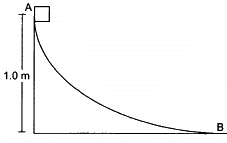
Given,
Weight of the block, mg = 10 N
Friction coefficient, μ = 0.2
Initial height of the block, H = 1 m
Initial velocity = Final velocity = 0
Potential energy of the block at the top of the curved track = Kinetic energy of the block at the bottom of the track
⇒ K.E. = mgh = 10 x 1 = 10J
Again on the horizontal surface the frictional force,
So, the K.E. is used to overcome friction.
The block stops after covering 5 m on the rough surface.
Q.38. A uniform chain of mass m and length l overhangs a table with its two third part on the table. Find the work to be done by a person to put the hanging part back on the table.
Let 'dx' be the length of an element at distance x from the table.
Mass of the element, 'dm' = (m/I)dx
Work done to putting back this mass element on the table is
So, total work done to put (1/3) part back on the table
The work to be done by a person to put the hanging part back on the table is (mgl/18).
Q.39. A uniform chain of length L and mass M overhangs a horizontal table with its two third part on the table. The friction coefficient between the table and the chain is μ . Find the work done by friction during the period the chain slips off the table.
Let x length of the chain be on the table at a particular instant.
Consider a small element of length 'dx' and mass 'dm' on the table.
dm = (M/L)dx Work done by the friction on this element is
Total work done by friction on two third part of the chain,
The total work done by friction during the period the chain slips off the table is
Q.40. A block of mass 1 kg is placed at point A of a rough track shown in figure following. If slightly pushed towards right, it stops at point B of the track. Calculate the work done by the frictional force on the block during its transit from A to B.
Given,
Mass of the block, m = 1 kg
Height of point A, H = 1 m
Height of point B, h = 0 . 8 m
Work done by friction = Change in potential energy of the body
The work done by the frictional force on the block during its transit from A to B is - 2 joule.
Q.41. A block of mass 5 kg is suspended from the end of a vertical spring which is stretched by 10 cm under the load of the block. The block is given a sharp impulse from below, so that it acquires an upward speed of 2⋅ m/s. How high will it rise? Take g = 10 m/s2.
Given,
Mass of the block, m = 5 kg
Compression in the string with the load, x = 10 cm = 0 . 1 m
Initial speed in upward direction, v = 2 m/s,
h = ?, g = 10 m/sec2
So, F = kx = mg
Total energy just after the impulse,
Total energy at a height h
= (1/2)k(h - x)2 - mgh
On solving, we get:
h = 0.2 m
= 20 cm
Q.42. A block of mass 250 g is kept on a vertical spring of spring constant 100 N/m fixed from below. The spring is now compressed 10 cm shorter than its natural length and the system is released from this position. How high does the block rise ? Take g = 10 m/s2.
Given,
Mass of the block, m = 250 g = 0 . 25 kg,
Spring constant, k = 100 N/m
Compression in the string, x = 10 cm = 0 . 1 m,
Acceleration due to gravity, g = 10 m/ s2
Let the block rises to height h.
Applying law of conservation of energy which says that the total energy should always remain conserved.
So, the block rises to 20 cm.
Q.43. Following figure shows a spring fixed at the bottom end of an incline of inclination 37°. A small block of mass 2 kg starts slipping down the incline from a point 4⋅8 m away from the spring. The block compresses the spring by 20 cm, stops momentarily and then rebounds through a distance of 1 m up the incline. Find (a) the friction coefficient between the plane and the block and (b) the spring constant of the spring. Take g = 10 m/s2.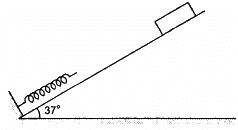
Given:
Mass of the block, m = 2 kg
Initial distance of the block from the spring, S1 = 4.8 m,
Comression in the spring, x = 20 cm = 0 . 2 m
Final distance of the block from the spring, S2 = 1m
Applying the work-energy principle for downward motion of the block,
Similarly for the upward motion of the body the equation is
Adding equations (i) and (ii), we get:
96μ = 48
⇒ μ = 0.5
Now putting the value of μ in equation (i), we get:
k = 1000 N/m
Q.44. A block of mass m moving at a speed ν compresses a spring through a distance x before its speed is halved. Find the spring constant of the spring.
Let the velocity of the body at P be v.
So, the velocity of the body at Q is (v/2). Energy at point P = Energy at point Q
Q.45. Consider the situation shown in the following figure. Initially the spring is unstretched when the system is released from rest. Assuming no friction in the pulley, find the maximum elongation of the spring.
Mass of the body is m.
Let the elongation in the spring be x.
Applying the law of conservation of energy,
(1/2) kx2 = mgx
⇒ x = 2 mg/k
Q.46. A block of mass m is attached to two unstretched springs of spring constants k1 and k2 as shown in the following figure. The block is displaced towards the right through a distance x and is released. Find the speed of the block as it passes through the mean position shown.
The body is displaced x towards the right.
Let v be the velocity of the body at its mean position.
Applying the law of conservation of energy,
Q.47. A block of mass m sliding on a smooth horizontal surface with a velocity  meets a long horizontal spring fixed at one end and with spring constant k, as shown in following figure following. Find the maximum compression of the spring. Will the velocity of the block be the same as
meets a long horizontal spring fixed at one end and with spring constant k, as shown in following figure following. Find the maximum compression of the spring. Will the velocity of the block be the same as  when it comes back to the original position shown?
when it comes back to the original position shown?
Let the compression in the spring be x.
(a) Applying the law of conservation of energy, maximum compression in the spring will be produced when the block comes to rest.
so change in kinetic energy of the block due to change in its velocity from u m/s to 0 will be equal to the gain in potential energy of the spring.
change in kinetic energy of the block=
gain in the potential energy of spring= (1/2)kx2
(b) No. The velocity of the block will not be same when it comes back to the original position. It will be in the opposite direction and the magnitude will be the same if we neglect all losses due friction and spring to be perfectly elastic.
Q.48. A small block of mass 100 g is pressed against a horizontal spring fixed at one end to compress the spring through 5 cm (figure following). The spring constant is 100 N/m. When released, the block moves horizontally till it leaves the spring. Where will it hit the ground 2 m below the spring?
Given:
Mass of the block, m = 100 g = 0 . 1 kg
Compression in the spring, x = 5 cm = 0 . 05 m
Spring constant, k = 100 N/m
Let v be the velocity of the block when it leaves the spring.
Applying the law of conservation of energy,
Elastic potential energy of the spring = Kinetic energy of the block
For the projectile motion,
Therefore, the block hits the ground at 1 m from the free end of the spring in the horizontal direction.
Q.49. A small heavy block is attached to the lower end of a light rod of length l which can be rotated about its clamped upper end. What minimum horizontal velocity should the block be given so that it moves in a complete vertical circle?
Let the velocity of the body at L is ν.
If the body is moving in a vertical plane then we need to find the minimum horizontal velocity which needs to be given to the body (velocity at L).
Also as point H is the highest point in the vertical plane so horizontal velocity at H will be zero.
Applying law of conservation of energy at points L and H,
Q.50. In the following figure shows two blocks A and B, each of mass of 320 g connected by a light string passing over a smooth light pulley. The horizontal surface on which the block A can slide is smooth. Block A is attached to a spring of spring constant 40 N/m whose other end is fixed to a support 40 cm above the horizontal surface. Initially, the spring is vertical and unstretched when the system is released to move. Find the velocity of the block A at the instant it breaks off the surface below it. Take g = 10 m/s2.
Given:
Mass of each block, m = 320 g = 0 . 32 kg
Spring constant, k = 40 N/m
h = 40 cm = 0 . 4 m and g = 10 m/ s2
From the free-body diagram,
kx cosθ = mg
As, when the block breaks of the surface below it (i.e. gets dettached from the surface) then R = 0.
Let the velocity of body B be v.
Change in K.E. = Work done (for the system)
From the figure,
From the principle of conservation of energy,
When the motion of the block breaks of the surface below it (i.e gets dettached from the surface on which it was initially placed) then
Putting the value of θ in equation (ii), we get: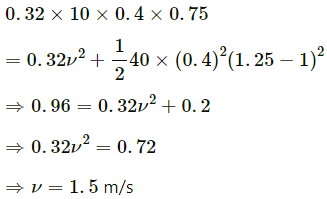
Q.51 .One end of a spring of natural length h and spring constant k is fixed at the ground and the other is fitted with a smooth ring of mass m which is allowed to slide on a horizontal rod fixed at a height h (following figure). Initially, the spring makes an angle of 37° with the vertical when the system is released from rest. Find the speed of the ring when the spring becomes vertical.
θ = 37º, l = natural length h
Let the velocity be 'v'
Applying the law of conservation of energy,
Q.52. Figure following shows a light rod of length l rigidly attached to a small heavy block at one end and a hook at the other end. The system is released from rest with the rod in a horizontal position. There is a fixed smooth ring at a depth h below the initial position of the hook and the hook gets into the ring as it reaches there. What should be the minimum value of h so that the block moves in a complete circle about the ring?
Let v be the minimum velocity required to complete a circle about the ring.
Applying the law of conservation of energy,
Total energy at point A = Total energy at point B
Let the rod be released from a height h.
Total energy at A = Total energy at B
So, h = l
Q.53. The bob of a pendulum at rest is given a sharp hit to impart a horizontal velocity  where l is the length of the pendulum. Find the tension in the string when (a) the string is horizontal, (b) the bob is at its highest point and (c) the string makes an angle of 60° with the upward vertical.
where l is the length of the pendulum. Find the tension in the string when (a) the string is horizontal, (b) the bob is at its highest point and (c) the string makes an angle of 60° with the upward vertical.
(a) Let the velocity at B be v1.
So, the tension in the string at the horizontal position,
= 8mg
(b) Let the velocity at C be v2.
So, the tension in the string is given by
(c) Let the velocity at point D be v4.
Again,
So, the tension in the string,
Q.54. A simple pendulum consists of a 50 cm long string connected to a 100 g ball. The ball is pulled aside so that the string makes an angle of 37° with the vertical and is then released. Find the tension in the string when the bob is at its lowest position.
From the figure,
Total energy at A = Total energy at B
So, the tension is given by
Q.55. Following figure following shows a smooth track, a part of which is a circle of radius R. A block of mass m is pushed against a spring of spring constant k fixed at the left end and is then released. Find the initial compression of the spring so that the block presses the track with a force mg when it reaches the point P, where the radius of the track is horizontal.
Given,
normal force on the track at point P,
N = mg
As shown in the figure,
Total energy at point A = Total energy at point P
Q.56. The bob of a stationary pendulum is given a sharp hit to impart it a horizontal speed of  Find the angle rotated by the string before it becomes slack.
Find the angle rotated by the string before it becomes slack.
Suppose the string becomes slack at point P.
Let the bob rise to a height h.
h = l + l cos θ
From the work-energy theorem,
Using equation (i) and (ii) and the value of u, we get,
Q.57. A heavy particle is suspended by a 1⋅5 m long string. It is given a horizontal velocity of  (a) Find the angle made by the string with the upward vertical when it becomes slack. (b) Find the speed of the particle at this instant. (c) Find the maximum height reached by the particle over the point of suspension. Take g = 10 m/s2.
(a) Find the angle made by the string with the upward vertical when it becomes slack. (b) Find the speed of the particle at this instant. (c) Find the maximum height reached by the particle over the point of suspension. Take g = 10 m/s2.
Given:
Length of the string, L = 1 . 5 m
Initial speed of the particle, u =
Change in K.E. = Work done
Putting the value of v from equation (i),
(b) From equation (ii),
(c) As the string becomes slack at point P, the particle will start executing a projectile motion.
h = OF + FC
Q.58. A simple pendulum of length L with a bob of mass m is deflected from its rest position by an angle θ and released (following figure). The string hits a peg which is fixed at a distance x below the point of suspension and the bob starts going in a circle centred at the peg. (a) Assuming that initially the bob has a height less than the peg, show that the maximum height reached by the bob equals its initial height. (b) If the pendulum is released with  find the maximum height reached by the bob above its lowest position before the string becomes slack. (c) Find the minimum value of x/L for which the bob goes in a complete circle about the peg when the pendulum is released from θ = 90°.
find the maximum height reached by the bob above its lowest position before the string becomes slack. (c) Find the minimum value of x/L for which the bob goes in a complete circle about the peg when the pendulum is released from θ = 90°.
(a) When the bob has an initial height less than the distance of the peg from the suspension point and the bob is released from rest (Fig.(i)), let body travels from A to B then by the principle of conservation of energy (total energy should always be conserved) Total energy at A = Total energy at B
So, the maximum height reached by the bob is equal to the initial height of the bob.
(b) When the pendulum is released with θ = 90° and x = L/2,
Let the string become slack at point C, so the particle will start making a projectile motion.
Applying the law of conservation of emergy
[because, distance between A and C in the vertical direction is
Again, from the free-body diagram (fig. (ii)),
[because, Tc = 0]
From equations (i) and (ii),
To find highest position C1 upto which the bob can go before the string becomes slack.(as we have found out the value of α so now we want to find the distance of the highest point upto which the bob goes before the string becomes slack, using this value of α .
(c) If the particle has to complete a vertical circle at the point C,
Again, applying energy conservation principle between A and C
From equations (i) and (ii),
So, the minimum value of (x/L) should be 0.6.
Q.59. A particle slides on the surface of a fixed smooth sphere starting from the topmost point. Find the angle rotated by the radius through the particle, when it leaves contact with the sphere.
Let the velocity be v when the body leaves the surface.
From the free-body diagram,
Again, from the work-energy principle,
Change in K.E. = Work done
From (i) and (ii),
Q.60. A particle of mass m is kept on a fixed, smooth sphere of radius R at a position where the radius through the particle makes an angle of 30° with the vertical. The particle is released from this position. (a) What is the force exerted by the sphere on the particle just after the release? (b) Find the distance travelled by the particle before it loses contact with the sphere.
(a) When the particle is released from rest, the centrifugal force is zero.
N force = mg cosθ = mg cos 30º
(b) Consider that the particle loses contact with the surface at a point whose angle with the horizontal is θ .
From equations (i) and (ii),
So, the distance travelled by the particle before losing contact,
Putting the value of θ, we get:
L = 0.43 R
Q.61. A particle of mass m is kept on the top of a smooth sphere of radius R. It is given a sharp impulse which imparts it a horizontal speed ν. (a) Find the normal force between the sphere and the particle just after the impulse. (b) What should be the minimum value of ν for which the particle does not slip on the sphere? (c) Assuming the velocity ν to be half the minimum calculated in part, (b) find the angle made by the radius through the particle with the vertical when it leaves the sphere.
(a) Radius = R
Horizontal speed = v
From the above diagram:
Normal force,
(b) When the particle is given maximum velocity, so that the centrifugal force balances the weight, the particle does not slip on the sphere.
(c) If the body is given velocity v1 at the top such that,
Let the velocity be v2 when it loses contact with the surface, as shown below.
So,
From equations (i) and (ii),
Q.62.1. Figure ( following ) shows a smooth track which consists of a straight inclined part of length l joining smoothly with the circular part. A particle of mass m is projected up the incline from its bottom. Find the minimum projection-speed v0 for which the particle reaches the top of the track.
Net force on the particle at A and B F = mg sin θ Work done to reach B from A, W = FS = mg sinθ| Again, work done to reach B to C
= mgh
= mg R (1 - cosθ)
So, total work done
Now, change in K.E. = Total work done
Q.62.2. Figure ( following ) shows a smooth track which consists of a straight inclined part of length l joining smoothly with the circular part. A particle of mass m is projected up the incline from its bottom. Assuming that the projection-speed is v0 and that the block does not lose contact with the track before reaching its top, find the force acting on it when it reaches the top.
(b) When the block is projected at a speed:
Let the velocity at C be v0.
Applying energy principle,
So, force acting on the body,
Q.62.3. Figure ( following ) shows a smooth track which consists of a straight inclined part of length l joining smoothly with the circular part. A particle of mass m is projected up the incline from its bottom. Assuming that the projection-speed is only slightly greater than v0, where will the block lose contact with the track?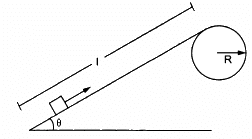
Let the loose contact after making an angle θ.
Q.63.1. A chain of length l and mass m lies on the surface of a smooth sphere of radius R > l with one end tied to the top of the sphere. Find the gravitational potential energy of the chain with reference level at the centre of the sphere.
Let us consider a small element, which makes angle 'dθ' at the centre.
Gravitational potential energy of 'dm' with respect to centre of the sphere
∴ Total gravitational potential energy,
Q.63.2. A chain of length l and mass m lies on the surface of a smooth sphere of radius R > l with one end tied to the top of the sphere. Suppose the chain is released and slides down the sphere. Find the kinetic energy of the chain, when it has slid through an angle θ.
Let us consider a small element, which makes angle 'dθ' at the centre.

When the chain is released from rest and slides down through an angle θ,
Change in K.E. of the chain = Change in potential energy of the chain
Q.63.3. A chain of length l and mass m lies on the surface of a smooth sphere of radius R > l with one end tied to the top of the sphere. Find the tangential acceleration dv/dt of the chain when the chain starts sliding down.
Let us consider a small element, which makes angle 'dθ' at the centre.
Since,
Taking derivative of both sides with respect to 't', we get:
Q.64. A smooth sphere of radius R is made to translate in a straight line with a constant acceleration a. A particle kept on the top of the sphere is released at zero velocity with respect to the sphere. Find the speed of the particle with respect to the sphere as a function of the angle θ it slides.
Suppose the sphere moves to the left with acceleration 'a'
Let m be the mass of the particle.
The particle 'm' will also experience inertia due to acceleration 'a' as it is in the sphere. It will also experience the tangential inertia force
From the diagram,
Integrating both sides, we get:
|
134 docs
|





